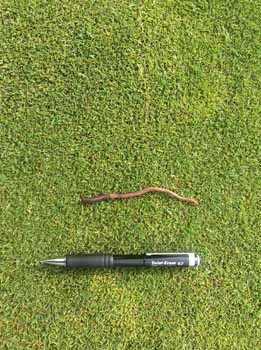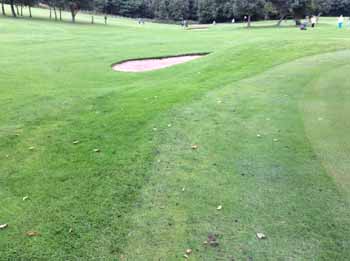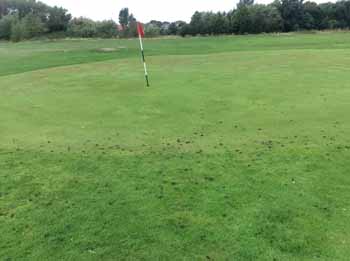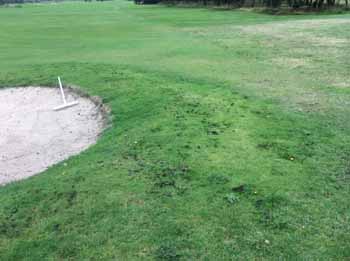How do you control earthworms without chemicals?
Related Articles
With chemical control of earthworms consigned to history, agronomist Emma Beggs looks at ways to reduce the problem of casts on sports surfaces.
‘It may be doubted whether there are many other animals which have played so important a part in the history of the world as these lowly organised creatures’.
After 39 years studying earthworms the naturalist, biologist and geologist Charles Darwin made this statement in his final publication Earthworms. They clearly have a critical role to play in soils and the wider ecosystems. Earthworms aerate soils, develop soil structure required for drainage and air exchange, incorporate organic matter and recycle nutrients through working in the soil system.

For those managing sports turf playing surfaces it is hard to see earthworms in such a positive light. One of the biggest problems facing greenkeepers during the 1920s and 1930s was earthworm casts spoiling the quality of turf playing surfaces. Early in the work of research, trials focused on finding ways to reduce levels of casting.
Their benefit underground remains undisputed but it is the problems caused by earthworms casting on the surface of close mown sports turf surfaces which create such difficulties, even if only caused by a small number of the 25 or so earthworm species found in the UK.
These surface soil casts result in muddy, slippery turf surfaces with the casts smearing when trodden on or mown. Levels of broad-leaved weed increase rapidly as weed seeds are brought up to the surface and bare spots of soil provide ideal conditions for weeds to establish.
On golf greens, surrounds and approaches good surface levels enables good contact between the golf ball and the immediate turf surface, which is so crucial to providing high quality playing surfaces.
Surface casting results in a loss of levels through these areas and a decline in playing quality.
It isn’t only golf which benefits from cast-free turf, bowling greens also suffer from the same problems. For football and rugby, the problems of earthworm casting are not as obvious but for those who have invested in drainage systems, earthworm casting rates are a potentially damaging problem. Earthworms cast into drainage aggregate affects infiltration rates, and surface sand slits can quickly cap over from casts smeared through play and mowing equipment, sealing over the free-draining sand surface.

In the early years, trial work indicated that good earthworm control could be achieved with chemicals including mowrah meal, derris dust and perchloride of mercury. This was then followed with the use of more effective chemicals through the 1960s including lead arsenate and chlordane. Cultural practices such as using acidifying fertilisers and boxing off clippings were also shown to reduce earthworm numbers. A combined approach meant that managed turf surfaces stayed pretty much cast free, even if the impacts of the use of the chemical products on the wider environment were being ignored.
Until the early 1990s, earthworm casting was pretty well managed. However, as the harmful impact of these chemicals was identified, steps were taken to remove them from use. The removal of chlordane had the most significant impact and since then remaining chemicals have had very short periods of control. Timing of application in conjunction with ongoing cultural practices provided the turf manager with a reasonable, if not great, level of control.
In recent years, carbendazim was the only product available and although it did not give casting control for significant periods of time, it was effective at suppressing casting for four to six weeks or so. If applications were timed carefully, it was a useful product for damping down casting at key times in spring and autumn when soils were damp, temperatures were warm and casting rates were at their highest.
With the withdrawal of carbendazim, from use, we have now come full circle. For all the advances made in machinery, materials and technical knowledge over the last 90 years, enabling us to develop better quality turf surfaces, it is perhaps ironic that we are again facing the same problems as those involved in the very early years of golf course management.

As turf managers, what options remain practical and feasible? We need to return to the key points identified by early research, manipulating soil conditions to ensure they don’t favour heavy earthworm activity. Cultural practices must again become the focus. We need to do all we can to make the soil environment less attractive and encourage earthworms to move into other areas. In addition, we need to educate golfers, explain that casting levels will increase – particularly on heavier soils on inland courses – and start to accept that thresholds for what is acceptable will be challenged. You will have to consider:
- Controlling the earthworm food supply through lowering organic matter levels. This may not be practical across large areas, however for tees, surrounds and approaches this should be feasible.
- Boxing off clippings to help lower the available food supply. Again, this may not be practical across large areas due to the quantity of clippings produced, especially on parkland courses, however it may need reconsidering for key problem areas.
- Manipulating soil pH with acidifying fertilisers such as ammonium sulphate or ammonium nitrate, or, if conditions are appropriate, through specific pH altering products based on sulphur or iron sulphate. Note that soil pH adjustment needs to be done with care following accurate soil pH testing and only if there is the option to lower soil pH. The over-application of sulphur to turf can cause significant delayed scorch problems so take care when using and applying sulphur-based materials.
- Increasing sand content through sand dressing. The application of a suitable (lime free) sports sand will discourage earthworms who dislike the abrasiveness and will be encouraged to move to other areas. The cost of sand will restrict the size of areas that turf managers can treat but by concentrating on key areas, landing zones and surrounds for example, this is an option that will need to be introduced on many sites.

There is no immediate solution to the problem of earthworm casting and it is likely that for many sites casting will cause significant problems not only for the turf managers but also the users of the sports facilities. Sadly this muddy war won’t be ending anytime soon.
Emma Beggs is an STRI agronomist

























